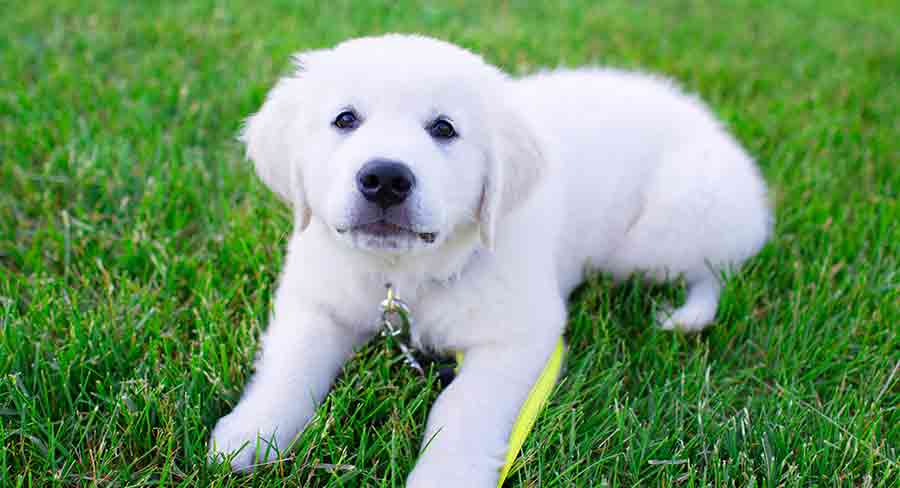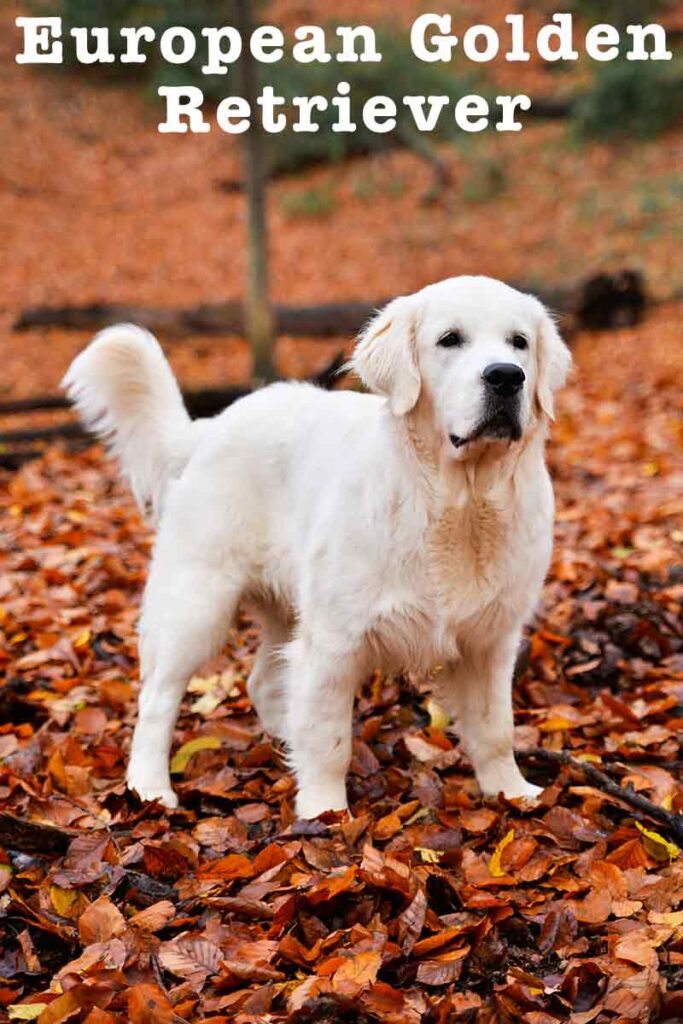
European Golden Retriever puppies are highly sought after at the moment. But there is very little which separates European Golden Retrievers from American Golden Retrievers. The differences lie mostly in their appearance. Prospective puppy buyers should take all the same precautions to find a healthy puppy with a good temperament. So, let’s take a closer look at the European Golden Retriever to find out if this breed will suit your family!
What Is A European Golden Retriever?
A European Golden Retriever is simply, a Golden Retriever from Europe. They are not a unique, distinct breed. Nor are they even very different in appearance from Goldens reared on other continents. They don’t even bark with a European accent.
But, more and more people are searching for European Golden Retriever puppies. Perhaps because someone has told them that European Goldens are better somehow. Or that they are healthier. Or come in colors that home-reared Goldens don’t. In this article, we’ll find out how much of that is true, and how much is urban myth, or savvy marketing by cynical breeders.
Types Of Golden Retriever
The Golden Retriever can trace its roots back to the 19th century. A Scottish aristocrat named Lord Tweedmouth founded the breed as a gentleman’s hunting dog and retriever. Lord Tweedmouth wanted a dog with a thick double coat, who wouldn’t mind the cold Scottish climate. The first litters he bred had a mix of yellow puppies, and puppies in other colors. It appears his decision to focus on breeding all-yellow litters as the breed developed was purely a matter of personal taste!
Goldens were recognized by the United Kingdom Kennel Club in 1911. Around the same time, fans of the breed started taking them to America and Canada. The Canadian Kennel Club (CKC) recognized the new breed in 1925. And the American Kennel Club (AKC) followed suit in 1932.
Different breed standards
This recognition by three separate breed registries is the crux of why European Goldens are sometimes described as being distinct from American Goldens. Each breed registry has drafted and agreed its own description of the ideal Golden Retriever. This is known as a breed standard.
Most countries outside of the USA and Canada use the breed standard set by the Federation Cynologique Internationale, who in turn have adopted the UK Kennel Club version. So European Golden Retriever breeders trying to produce show-quality Goldens follow the UK breed standard, and American breeders follow the AKC standard.
Let’s compare!
The different breed standards prioritize detail in different areas. For example, take a look at how each registry describes the ideal Golden’s feet: The AKC say they are –
“Feet medium size, round, compact and well knuckled, with thick pads.”
Lots of detail there! The CKC standard is briefer –
“Feet medium size, round and compact with thick pads.”
Whilst the UK Kennel Club standard simply says:
“Round and cat like.”
So, it’s easy to see how breeders pursuing Golden perfection would end up with different looking dogs in each country. And we haven’t even gotten past the toes yet! Let’s have a look at a couple of other ways American vs European Golden Retriever breeders might breed different-looking dogs.

European Golden Retriever Coat Color
A popular idea about European Golden Retrievers is that they come in rare, extra-light colors. In fact we’ve already looked at the English Cream Golden Retriever in more detail in this article. Let’s compare the breed standards again. The UK Kennel Club breed standard, adopted across Europe says coat color is:
”Any shade of gold or cream, neither red nor mahogany.”
And the AKC standard says it is:
”Rich, lustrous golden of various shades.”
In fact, as you can see in this striking photo on the Golden Retriever Club of America’s site, Goldens’ coats come in a broad scale of colors. It’s easy to see though, why including the words ‘rich’ and ‘lustrous’ in the U.S. breed standard prompted breeders to favor the darkest shades. Whilst in Europe, pale colors are specifically mentioned. So breeders hoping to achieve the best match to the standard and win show titles would err towards light-colored puppies.
European Golden Retriever Size
Another point of difference in the breed standards is size. According to the original European breed standard, the ideal female Golden Retriever is 20 to 22 inches tall at the withers (shoulder blades). And the ideal male is 22 to 24 inches tall. But in the AKC breed standard, the ideal female is 21.5 to 22.5 inches tall, and the ideal male is 23 to 24 inches tall. So for Americans, as in so many areas of life, bigger is better when it comes to Golden Retrievers. And European Goldens are on average more petite in comparison.
American Vs European Golden Retrievers
What’s important to remember, in all these examples, breeders on both continents are still working with the same breed of dog. They can still trace their lineage back to Lord Tweedmouth, and his founding dogs. But differences in opinion about the ideal Golden Retriever has meant that in each country, breeders have typically tried to achieve slightly different looks. Looks aren’t everything when it comes to owning a dog. So how do they compare in terms of temperament and health?
European Golden Retriever Temperament
In English and American Labradors, there is a marked difference in temperament. But at the moment this is not so for Golden Retrievers. European Goldens, like Goldens the world over, are the ultimate people dog. They love meeting people, playing with people, and training with people. Not to mention cuddling up to them!
Their love isn’t confined to their own family either. Goldens are typically friendly to a fault. There is no one and nothing they won’t cover at high speed to say hello to. To get the most of your Golden’s temperament, socialize them to lots of different situations while they are still under 12 weeks old, and teach them to greet new people by sitting down for a treat, rather than jumping up!
European Golden Retriever Health
Golden Retrievers of all types are prone to
- joint diseases, including hip and elbow dysplasia
- thyroid disease
- cancer
- and a scaly skin condition called ichthyosis.
They live for 11-13 years, on average. All adult Goldens should be tested for hip and elbow dysplasia, heart disease and eye disease before they are used for breeding. Dogs with a family history of skin problems or cancer should also be removed from breeding programmes.
Are European Gold Retrievers Healthier?
European Goldens are not healthier than any other type. The healthiest Goldens are bred from health tested parents, regardless of type. It’s nice to think that having gone to the trouble and expense of importing European Goldens to breed from, those breeders will be invested enough in the quality of their dogs to health test them before breeding. But always walk away from a breeder who claims that European Goldens are just innately healthier and don’t need health tests. They do!
European Golden Retriever Puppies
Despite their name, European Golden Retriever puppies are bred and sold all over the world. In Europe, they are simply called Golden Retrievers. This sets them apart from Labrador Retrievers, which have been bred in distinct English and American lineages for so long that owners on both sides of the Atlantic often specify which type they have.
European Golden Retrievers in the U.S. have either been imported from Europe, or bred from parents imported from Europe. Since they’re not as established as Goldens meeting the American standard, good breeders are more likely to have long waiting lists.
European Golden Retriever Summary
A European Golden Retriever was either born in Europe, or bred from parents imported from Europe. And it matches the UK Kennel Club breed standard more closely than the AKC standard. They are popular at the moment, because cynical breeders have capitalized on the idea that these differences make them rare, or somehow special. All Goldens are special, and have the same potential to be wonderful family pets.
The most important qualities to look for are health testing, parents with great temperaments, and breeders who socialise their puppies from a young age. Maybe one day European vs American Goldens will be distinct and in the same way as English and American Labradors. Watch this space to find out!
Do You Have A European Golden Retriever?
Tell us about them in the comments section down below!
Readers Also Liked
- Blue German Shepherd
- Red Golden Retriever
- Golden Retriever Mix Breeds
- Golden Retriever Training Tips
- European Labrador
- Labradoodle vs Goldendoodle
- Goldendoodle vs Golden Retriever
- Golden Cocker Retriever – The Perfect Mixture Of Personalities?
References
- Adams et al. Methods and mortality results of a health survey of purebred dogs in the UK. Journal of Small Animal Practice. 2010.
- Golden Retriever Club of America
- Kent et al. Association of cancer-related mortality, age and gonadectomy in golden retriever dogs at a veterinary academic center (1989-2016). Plos One. 2018.
- Official Standard of the Golden Retriever. AKC. 1981.
- Golden Retriever Breed Standard. CKC. 2004.
- Breed Standard – Retriever (Golden). Kennel Club. 1994.
- Orthopedic Foundation For Animals

Free Training Tips
Get Pippa's free dog training tips delivered to your inbox

 What To Do When Your Puppy Pees In The House
What To Do When Your Puppy Pees In The House